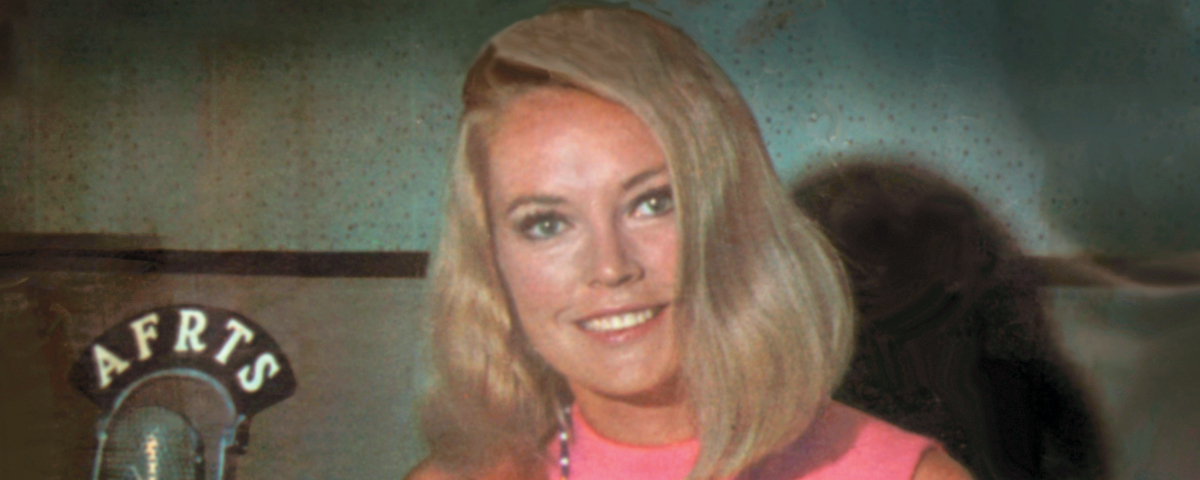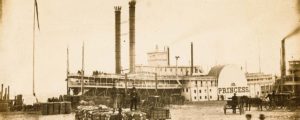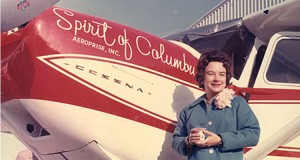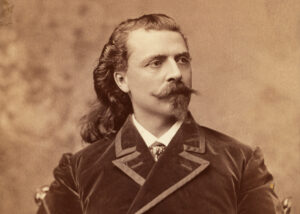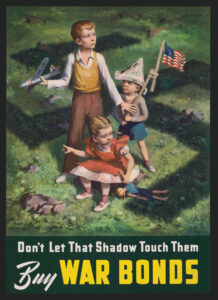As 1965 began, I felt on top of the world. Who wouldn’t be? After all, I had just finished shooting Girl Happy at MGM, where I got to meet and hang out with the King of Rock, Elvis Presley.
I’d worked hard to get to Hollywood from West Palm Beach, Fla., where I began modeling at age 16, appearing on the cover of Good Housekeeping magazine and doing stints as a Kodak Girl. I was a New York Giants cheerleader, and a finalist in the Miss Rheingold contest, when I met Hugh O’Brian, who was then playing Wyatt Earp on TV. He helped convince me I should become an actress, and off I went to Hollywood!
I was receiving a lot of letters from GIs, and I started reading parts of them on the air and playing the guys’ song requests and dedications.
After moving to Hollywood in 1963, I had some great successes, despite a Warner Brothers casting agent telling my agent that I had “absolutely no talent,’’ and the worst voice she’d ever heard. Not long after that, I landed a role as Steve McQueen’s girlfriend in Soldier in the Rain. I also got a part in a Gene Roddenberry TV series about the Marines, The Lieutenant, in which I played a different character in each episode. Gene called me a “rotating regular.”
So with Girl Happy in the theaters in the summer of 1965, life was good for me. I was very busy and had reached the point where I could actually turn down acting offers. I had no idea that before the year ended, my entire life would be turned upside down by a war in a place called Vietnam.
Before Christmas of 1965, out of the blue I got a call from Milton Berle’s wife, who was organizing a Christmas Day visit to wounded soldiers who were patients at the Balboa and Letterman Veterans hospitals in San Diego and San Francisco. She asked my roommate, actress Eileen O’Neill, and me if we would come along on the visit, joining California Governor Pat Brown, comedians Dan Rowan and Dick Martin, Los Angeles Dodgers pitcher Sandy Koufax and Milton Berle. We guessed it was because she thought we were pretty and could entertain the men in the hospital, but we really didn’t know what to expect. So Eileen and I worked out a little routine where we would sing “Diamonds Are a Girl’s Best Friend.”

When we arrived at the hospital, we toured different rooms, visiting patients, and Eileen and I performed our little act. Finally, we were ushered to the gangrene ward, where we had to scrub and put on gowns before we could enter. The staff announced to the patients that they had some surprise visitors and I was the first one to enter. The ward was full of amputees, some double and triple, and there was an uneasy silence when I walked into the room. Understandably, some of the guys were angry and bitter, and not crazy about having a bunch of people there to see them, especially pretty young girls. They just stared at us and I didn’t know what to do. Then, Sandy Koufax walked in with a baseball, and a guy at the end of the room called out, “Hey, Sandy, over here!” Sandy tossed the ball over, and the guy caught it with his one remaining hand. That pitch broke the tension and everyone cheered. We spent about an hour there, each of us taking time to talk to all the men.
Those moments in that hospital changed my life. As we walked out into the hallway, Sandy Koufax was crying and I was just numb. I prayed, “Please God, help me to be able to do something to help these young men in war.”
My opportunity soon came. I learned through my boyfriend at the time, the singer Jack Jones, that Armed Forces Radio, which had its studios in Los Angeles, was auditioning girls for a show. I had no idea what it was, but I went in for an audition, along with a lot of other girls. I was interviewed, and they recorded me reading some copy. A few days later, they called me back and offered me a job. I started out on a show hosted by George Church III, called Small World, where I was on the air with him reading copy and having a conversation. About two months into it, Colonel Robert Cranston, who was in charge, called me into his office and told me I was fired. “Why?” I asked. “What did I do wrong?” He smiled at me and said: “Chris, you’ve been rehired to do your own show. We’re calling it ‘A Date With Chris.’”
“A Date With Chris” was developed by my producer, Bill Ezell, and started running in the middle of 1966. Bill loved jazz, and I had grown more familiar with and appreciative of jazz through Jack. Bill wrote the scripts and I’d introduce the records and give public service announcements. The show was instantly a big hit.
That fall, Jack was recruited to join Bob Hope’s Christmas tour and I really wanted to go along. But they didn’t think I was a big enough star, so they turned me down; they said the tour was already filled. I was very disappointed until one day we received a wire at the radio studio from the Pentagon, asking me to volunteer to go to Vietnam—by myself—to help boost troop morale. I literally jumped for joy, I was so excited.
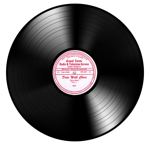 I soon came to realize that people stateside were not aware of the show’s impact and popularity among the troops in Vietnam because it wasn’t broadcast in the United States. It was only heard on the Armed Forces Radio Network, which had some 300 stations around the world.
I soon came to realize that people stateside were not aware of the show’s impact and popularity among the troops in Vietnam because it wasn’t broadcast in the United States. It was only heard on the Armed Forces Radio Network, which had some 300 stations around the world.
On my first trip to Vietnam, the guys were great and always said they loved the show, but really wanted me to play more Top 40, rock ’n’ roll music instead of jazz. So, when I got back to Los Angeles, I went to Colonel Cranston and told him that we should be playing more Top 40. “Really, Chris,” he said to me, “who do you think knows more about the radio business, you or us?” I told him I did! That I’d just come from Vietnam and the men there told me in person what they wanted, and they wanted more rock ’n roll. My producer wanted to stick with the standards, too, but he ended up quitting. Fortunately, the show’s new producer was open to the idea, so I started bringing in my own records and getting the newest music through friends of mine in the business.
When I told a disc jockey friend of mine in London about the show, he said: “Chris, you should have a catch phrase. You should open your show by saying ‘Hi, Love.’ ” I took his advice a step further and added at the end of the show: “Bye, Love. Here’s a kiss from Chris!”
I was forbidden to play certain songs because of their drug-use connotations, such as “Puff the Magic Dragon” and “Along Comes Mary.” I could play all the Beatles, though. I also started doing interviews with recording artists, such as Ray Charles, Marvin Gaye, Nancy Sinatra and other celebrities, giving them great exposure around the world.
I began making more trips to Vietnam and was away for a couple of weeks at a time, so prior to my departure I would have to pre-record shows. Sometimes I recorded up to 10 of the 55-minute shows in one day. That’s when I went from reading scripts to just ad libbing all the time. It was hard for me because I was really kind of shy, except when I was in front of a camera. It’s actually quite a challenge to sit in the studio by yourself and just talk into the mike.
I was receiving a lot of letters from GIs, and I started reading parts of them on the air and playing the guys’ song requests and dedications.
“Sergeant Oaks likes our program, and never misses it. Pfc Rice, with the 4th Infantry Division, happy birthday! And to the cats from the 1st Infantry Division, here’s a record high on the charts for Specialist Mike Barlett and all your buddies—’Groovin’ on a Sunday Afternoon,’ by the Young Rascals. That song is also for Charles Pace with the 519th Military Intelligence Battalion, who writes: ‘It’s monsoon season and it’s raining so hard it’s like living in a shower bath. The mosquitoes are as big as Hueys.‘ ”
“Charley of Battery 6/15 Artillery writes: ‘I have a question for you, Chris. How short are the dresses in the states now? The shorter the better!’ Well I have good news for you, Charlie. They’re still short. The mini-skirt is still in. The hemline is about 12 inches above the kneecap. That’s right. All the girls are running around in our mini-skirts. Charley also asked that I play a song for a groovy group of guys—Ernie, Chucky Poo, Harvey, Tom Tom, Skee Man, Tomato— sounds like a wild group! To open my program, here’s a Dionne Warwick song for you guys, high on the charts, ‘This Girl’s in Love With You.‘ “
“Let’s open the mailbag! I received a nice letter from Stephen Brown aboard the USS Redford. It seems Stephen has a problem. ‘Everyone knows how crowded it is on a destroyer, but we have a blank space on one bulkhead. It’s just a shade over a foot square, right next to a receiver we use to tune to your show.’ Steve wants me to send him a picture to hang up in that space. It’s on the way, autographed to you, Steve, and to all the guys on the USS Redford. And here’s a song for all of you, by the Beatles, ‘Come Together.’ ”
“And here’s a special message to all my friends in Vietnam. Fellas, don’t get hooked on drugs. Don’t go home a drug casualty. If you’re having a problem, discuss it with a medical officer or better yet, your chaplain. You’re all big boys now, so be careful! Now, back to our program. This is Chris Noel on A Date With Chris. I have a letter from Pfc Vell with Headquarters Battery, 3rd Battalion, 11th Marines, 1st Marine Division. He thanks me for the good music, and asks me to play a song for all his buddies. Here it is fellas, ‘The Letter’ by the Box Tops.”
Some letters really got to me. One GI wrote: “People back home just don’t understand. We are just people, like anybody else. Well, I’m going on a mission tomorrow, and it will probably take me from this crummy old world.” I often wonder what happened to him.
While my show was broadcast to U.S. forces all around the world, I knew it was most important to the guys who were fighting in Vietnam. And when I visited there, I could tell that what I did was an important morale booster for the GIs. One time, while visiting a hospital in-country, I was led into a room and told that a wounded soldier really wanted to see me. I went in and held his hand. He died a few moments later.
A National Enquirer writer once accused me of being a Pentagon war propagandist. “I’m no propagandist,” I replied, “I’m just a girl who’s trying to make the men she loves happy. You see, I’m in love with half a million men—all our American troops in Vietnam.” Leave it to the Enquirer to turn my words into a scandalous headline: “Chris Noel’s Love Affair with Half a Million Men.” But I didn’t really mind, because you can’t argue with the truth.
Chris Noel’s recently published memoir, Confessions of a Pinup Girl, is now available at HistoryNetShop.com.

